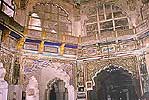|
 To the countless images on the shikhar and panels of the temple,
the floral patterns, images of animals and mythical features of
gods and Goddesses and demons – all are wonderful to look at.
The interior of the Jagmohan also has beautiful design in which
circular patterns have been drawn and joining these circles
interlacing patterns have also been made. Again images of Gods
and Goddesses are shown in these circles. The outer portion of
the temple is of two storeys over which canopies in the typical
Rajasthani style have been built. Behind the entrance, the
structure of the building is wider and the third portion is
still wider. Every where wherever there is scope, images of
animals of elephants, horses and images of Gods and Goddesses have been encarved. It is a wonderful creation of sculpture and
architecture.
To the countless images on the shikhar and panels of the temple,
the floral patterns, images of animals and mythical features of
gods and Goddesses and demons – all are wonderful to look at.
The interior of the Jagmohan also has beautiful design in which
circular patterns have been drawn and joining these circles
interlacing patterns have also been made. Again images of Gods
and Goddesses are shown in these circles. The outer portion of
the temple is of two storeys over which canopies in the typical
Rajasthani style have been built. Behind the entrance, the
structure of the building is wider and the third portion is
still wider. Every where wherever there is scope, images of
animals of elephants, horses and images of Gods and Goddesses have been encarved. It is a wonderful creation of sculpture and
architecture.
|

